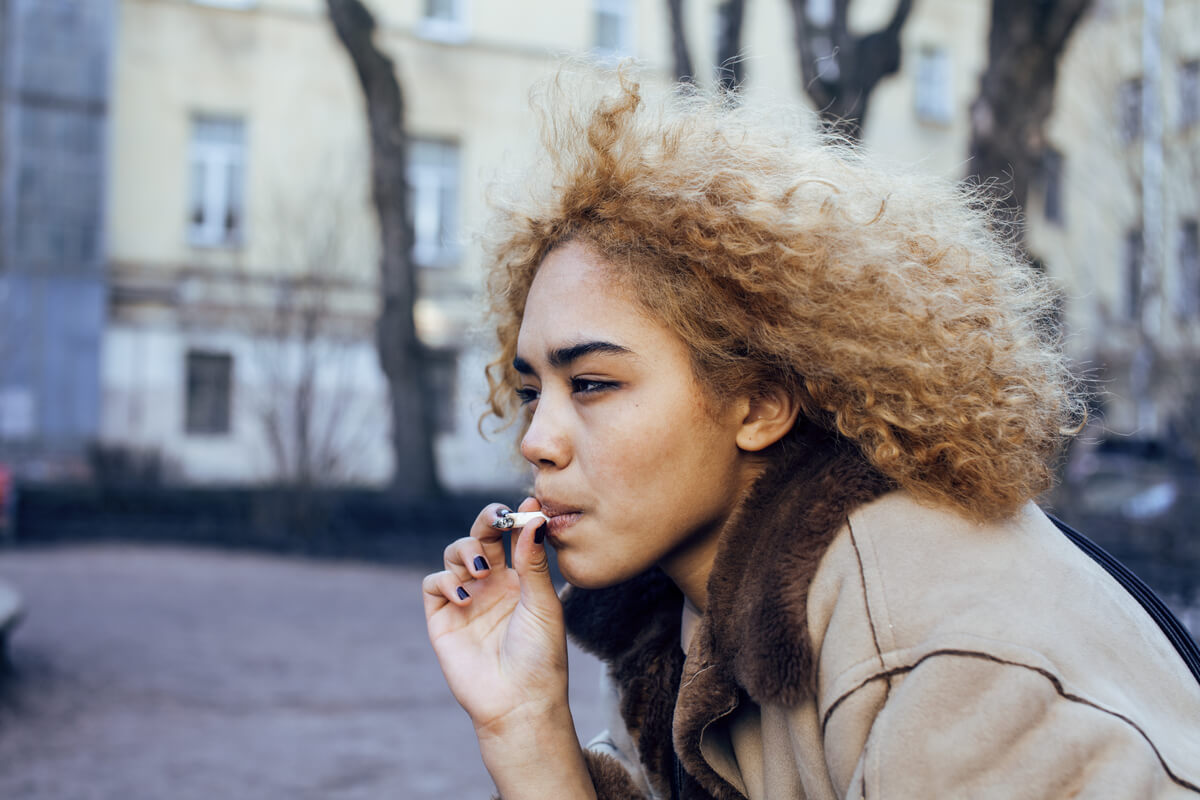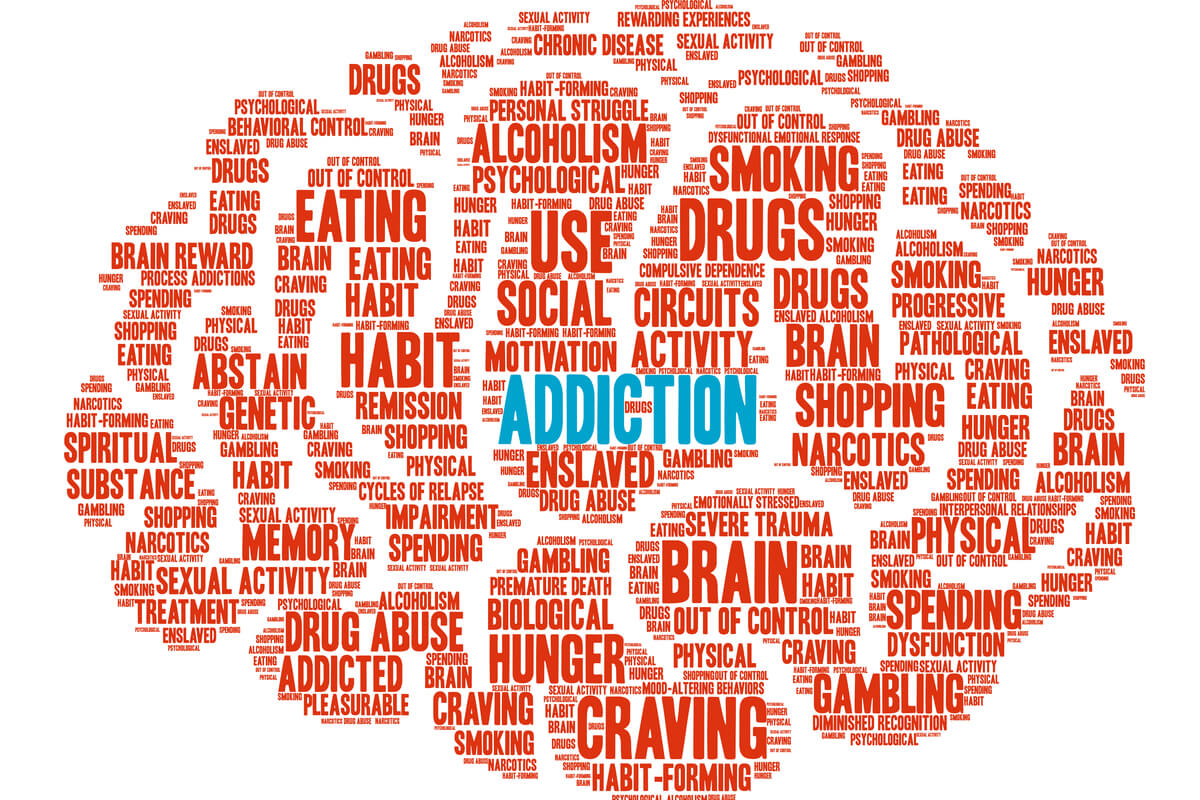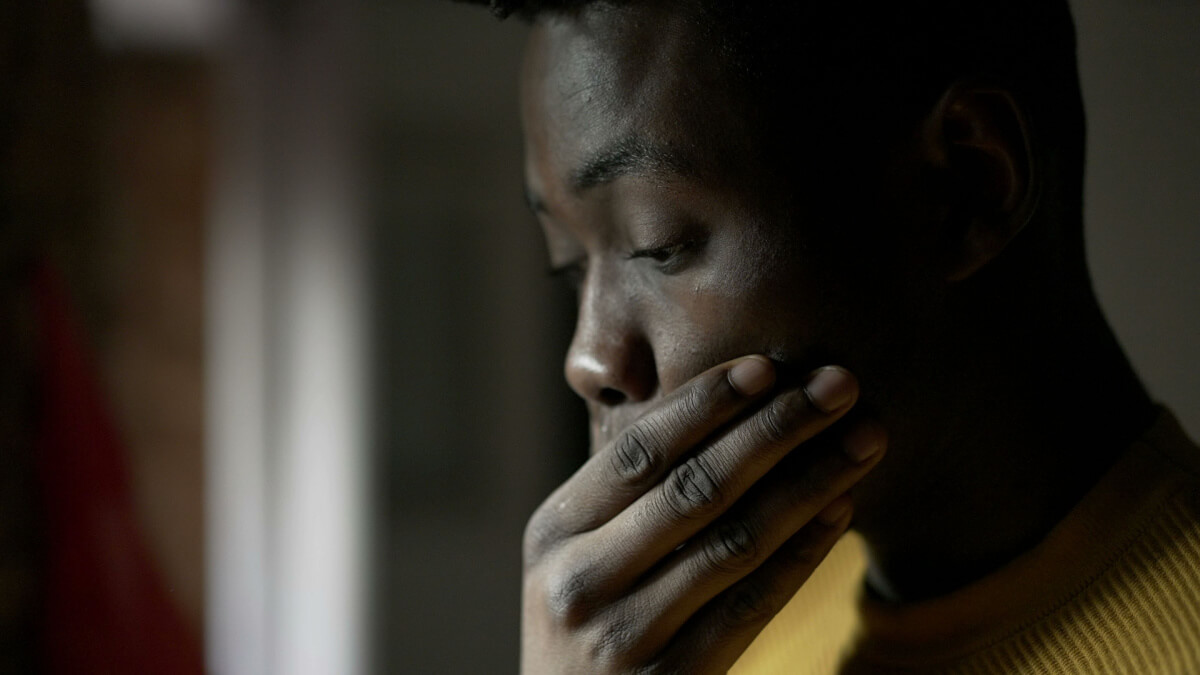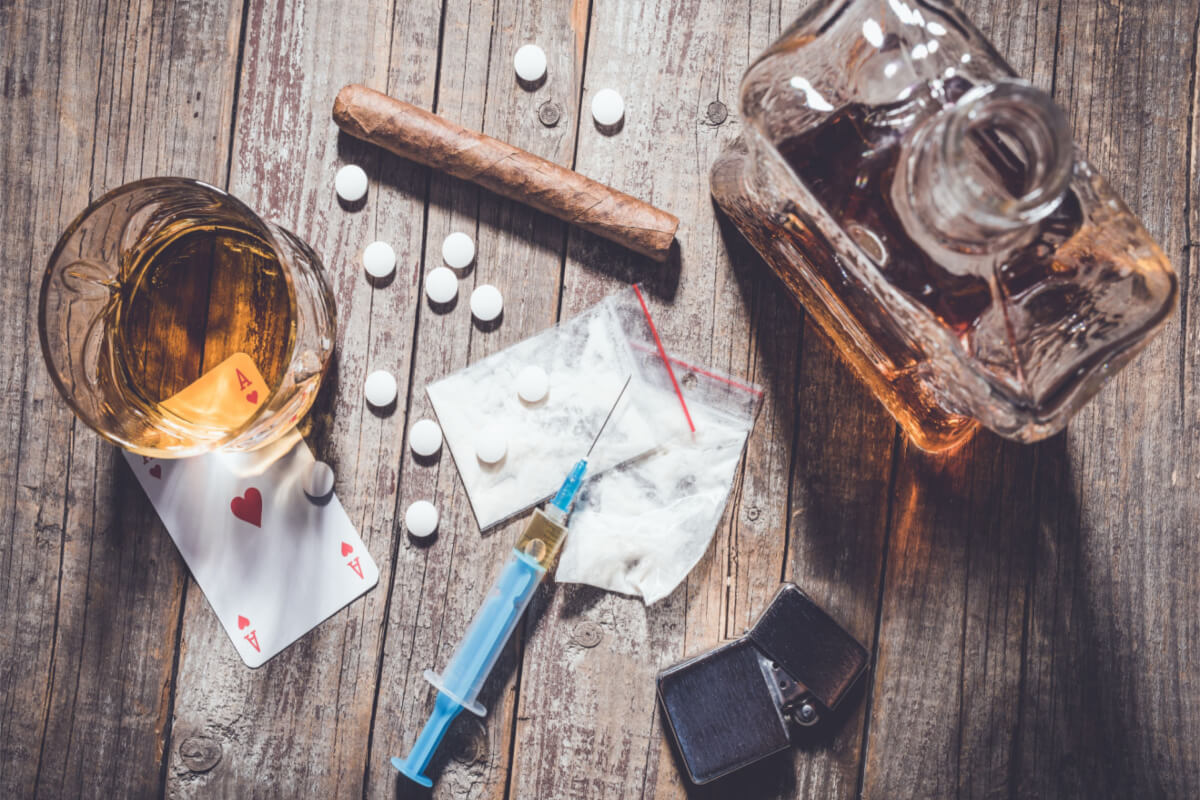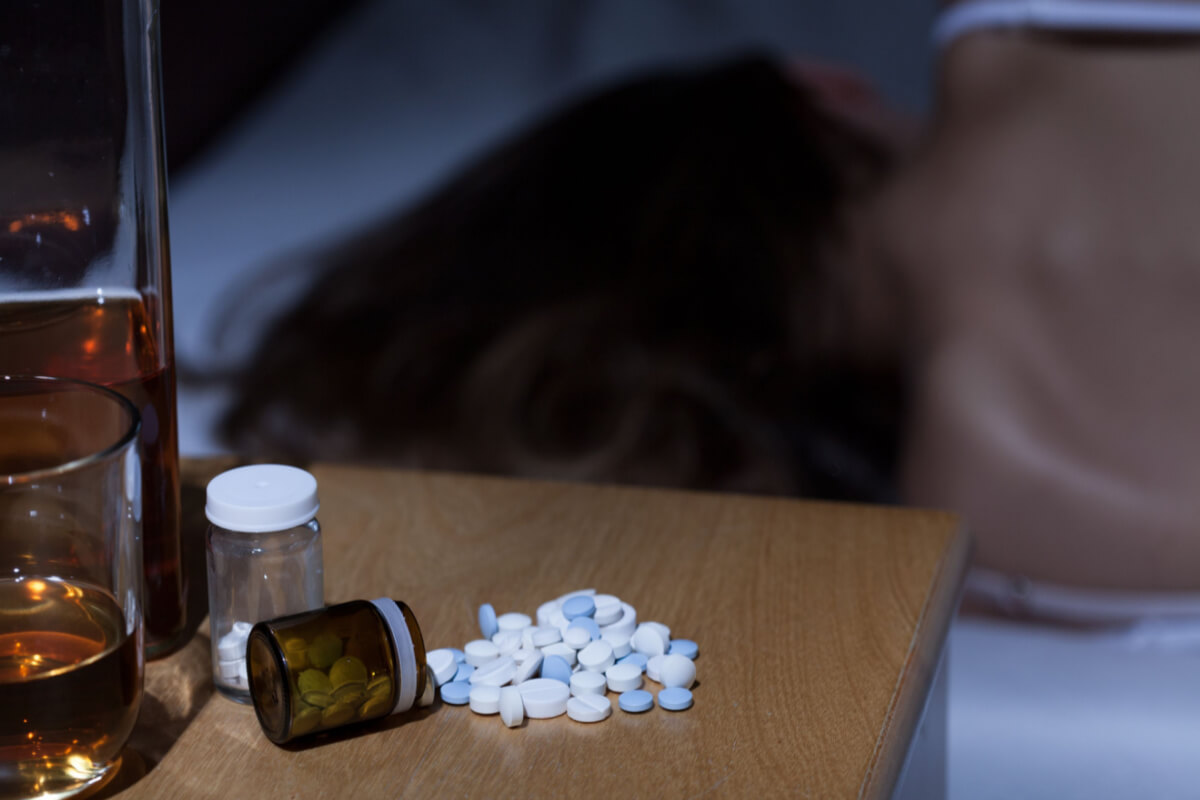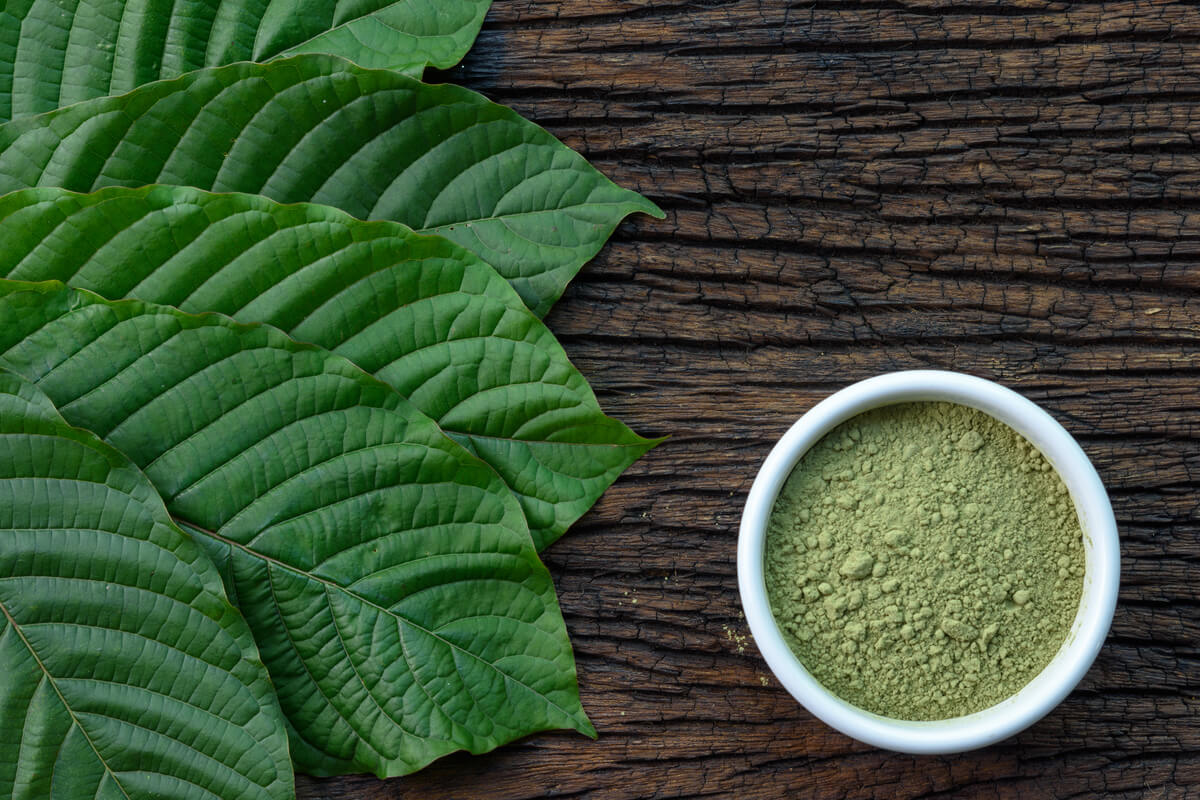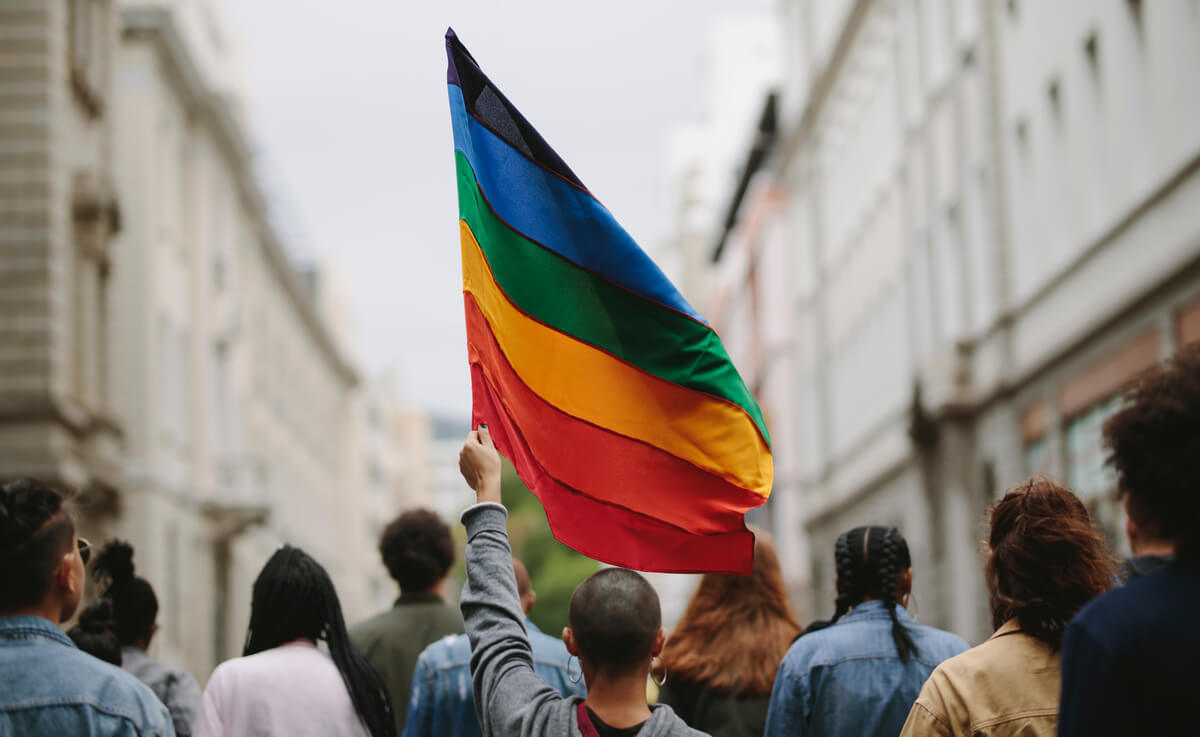
Between 5% and 10% of the U.S. population identifies as lesbian, bisexual or gay.[9] The LGBTQ+ community faces many challenges, including discrimination, bullying, lack of support, and high levels of daily and chronic stress. This can lead to an increased risk for substance use disorders.
LGBTQ individuals, or those in sexual-minority groups, experience rates of substance use disorders two to five times that of the general population.[1]
According to a national survey in 2019, just over 9% of the population ages 18 to 25 had an alcohol use disorder (AUD) compared to 12% of LGBTQ young adults. Adults ages 26 and older had an AUD just over five percent of the time while LGB adults of the same age had one nearly 12% of the time- more than double.[2,3]
Rates of opioid use disorder (OUD) among LGB adults was close to 2% in 2019, nearly two times the 0.6% rate of Americans overall.[2,3]
SUD rates are higher in the LGBTQ community than in the general population. Gender and sexually diverse populations have SUDs at rates nearly triple the rates of the general population (18.3% of LGB adults ages 18 and older versus 7.4% of Americans ages 12 and older).[2,3]
Pullquote: LGB people are three times more likely to have a substance use disorder than their heterosexual counterparts.
Rates of Substance Use & Misuse
Gender and sexually diverse persons have higher rates of drug and alcohol use and SUD than people who identify as heterosexual.[4]
Data is only recently being collected to distinguish exact trends, and many do not specify each specific subset of the LGBTQ community (lesbian, gay, bisexual, transgender, and queer or questioning), only certain populations.
The following information on LGB adults and substance use has been collected based on the 2019 national survey.[3]
LGBTQ+ Adults
Alcohol
Alcohol is the most commonly used addictive substance in the United States, as half of all Americans ages 12 and older report past-month alcohol use. Rates are even higher for gender diverse and sexually diverse persons, at closer to 60%.[3]
Prescription Drugs
Prescription and psychotherapeutic drugs include opioid pain relievers, sedatives such as benzodiazepines, prescription stimulants, and tranquilizers. This is the second-most misused type of drug by LGBTQ adults (16.1% in a survey from 2019). This is more than three times the rate of the general population of Americans for the same time period.[3]
Hallucinogens
Hallucinogens are not commonly misused by the general population ages 12 and older, as only 2% do so. However, LBG adults ages 18 and over use these drugs about four times as much, with 1.2 million LGBTQ people (8.4%) reporting past-year use.[3]
Cocaine
Cocaine is used at rates over 3 times higher by the LGBTQ community than the general population.. Over 7% of LGBTQ adults used cocaine in 2019 compared to around 2% of Americans overall.[3]
Inhalants
Inhalants (e.g., ‘whippets’, ‘poppers’) include gasses, solvents, aerosols and nitrates, and they are often found in household products. They are more commonly misused by younger people; however, they are not commonly misused overall by the general population. Rates are between 1.7% for young adults (ages 18 to 25) and 0.4% for older adults (ages 26 and over). In the LGB population, 4.3% of adults ages 18 and older reported past-year inhalant use.[3]
Methamphetamine
Meth is a potent and addictive illicit stimulant drug that only under 1% of each age demographic in the general population misuses. LGB adults, ages 18 and over, misuse meth at rates close to 3%, which is more than triple the general population.[3]
Heroin
Heroin is an illegal opioid drug misused at rates less than 0.5% in the general population but at rates more than double that in the LGB adult population.[3]
Tobacco
LBGTQ+ individuals are more likely than their heterosexual peers to smoke tobacco products, including cigarettes and e-cigarettes. [4]
Bisexual women report higher rates of e-cigarette use than heterosexual women and greater use of e-cigarettes and tobacco cigarettes compared to lesbians and heterosexual women.[4]
Moreover, bisexual men are more likely to use e-cigarettes compared to their heterosexual counterparts.[4]
LGBTQ+ YOUTH
There is not as much data on LGBTQ youth and substance use, but studies show that the odds for substance misuse in LBG youth is an average of 190% higher than among youth who identify as heterosexual.[5]
Females had a 400% higher risk, while bisexual youth represented a 340% higher risk rate.[5]
Gender and sexually diverse youth have higher rates of tobacco, alcohol, marijuana, cocaine and injection drug misuse than their peers who identify as heterosexual.
Substance Misuse Among Transgender and Nonbinary Individuals
Transgender and nonbinary youth and adults alike face an incredible amount of systemic and interpersonal discrimination, stigma and persecution.
Research shows that transgender people are more likely than their cisgender counterparts to use tobacco, including cigars, cigarettes and e-cigarettes. [23]
In general, transgender individuals have higher rates of substance misuse than cisgender people. This is particularly true for amphetamines and cocaine, which trans people are twice as likely to use, and inhalants, which trans individuals are three times as likely to use.[23]
Furthermore, transgender people are more likely to misuse prescription drugs than their cisgender counterparts. And this misuse was associated with increased depression, somatic distress, anxiety, discrimination based on gender identity and low self-esteem.[23]
Risk Factors & Challenges That LGBTQ+ Individuals Face
It is a sad reality that LGBTQ+ individuals continue to face discrimination, bullying, and stigma in our society. Many report being harassed, threatened, assaulted, or having experienced violence due to their gender identity or sexuality at some point in their lifetimes.
LBGTQ+ teens are twice as likely to be bullied, assaulted, and excluded at school. They are 40% less likely to have adult support in their life compared to adolescents who identify as heterosexual.[6] Chronic stressors such as these among LGBTQ+ can prompt substance misuse.[7]
Other risk factors and challenges that can contribute to addiction risk include:[21]
- Discrimination
- Societal homophobia
- Internalized homophobia
- Transphobia
- Family rejection due to sexuality or gender
- Concealment
- Social isolation
- Physical victimization
- Trauma
Chronic stress can also lead to mental health conditions, including depression and anxiety. Both issues also raise the risk of substance misuse and SUD. And the stress that queer and trans individuals face can be explained by the minority stress theory, which posits that marginalized people experience stress from discrimination and stigma, which puts them at risk for many harmful mental health and medical conditions and outcomes.[20]
Mental Health Among LGBTQ+ Individuals
Stigma in society, denial of civil and human rights, discrimination, experiences of violence and victimization, and a lack of personal, family, or social acceptance greatly impact the mental health of LGBTQ+ individuals.[8]
LGBTQ+ individuals have triple the odds of experiencing a mental health disorder compared to individuals who identify as heterosexual.[10]
Mood disorders, such as anxiety or depression, are common in LGBTQ+ individuals. LGBTQ+ individuals are therefore at a higher risk for suicidal thoughts and actions.[11]
High school students identifying as gay, lesbian, or bisexual are more than four times as likely as their peers to attempt suicide. Approximately 40% of transgender adults have attempted suicide at least once in their lifetime compared to less than 5% of the general population.[11]
Mental health issues and substance use disorder are closely connected. LGBTQ+ individuals who have a mental health condition are more likely to misuse substances and develop SUD, and the reverse is also true. Substance use can exacerbate mental health concerns and vice versa.
The Need for Specialized Treatment Options
Many in the LGBTQ+ community have faced stigma and barriers to quality and inclusive health care which fosters lack of trust in the medical system in general.
Treatment of SUD in the LGBTQ+ community needs to be trauma-informed and sensitive to the unique needs of this population.
However, there is currently a lack of culturally competent healthcare providers. Research indicates that only about 7% of treatment programs offer specialized services for LGBTQ+ people.[4]
Ideal treatment in this community includes both MAT but also access to providers, therapists, counselors, and a mental health team that has experience and familiarity working with LGBTQ+ patients and the unique concerns they face.
If you identify as LGBTQ+ and are also seeking treatment for a substance use disorder, reach out to Bicycle Health. We can help connect you with compassionate and inclusive care that meets your needs.
Treatment Resources for LGBTQ Community
- LGBTQ Mental Health Resources: A host of mental health crisis support and treatment referral information is provided by the Mental Health Coalition.[12]
- GLMA (Gay and Lesbian Medical Association’s) Provider Directory: View resources for health care professionals that are LGBTQ-friendly.[13]
- LGBT National Help Center: This organization provides free and confidential peer support and local resources.[14]
- National Center for Transgender Equality: This group provides resources on rights and a Health Coverage Guide.[15]
- National Queer and Trans Therapists of Color Network (NQTTCN): NQTTCN offers mental health resources for queer and trans people of color.[16]
- Human Rights Campaign (HRC) Healthcare Facility Search Key: Providers that participated in the Healthcare Equality Index Survey based on inclusivity and LGBTQ practices and policies are ranked.[17]
AA & NA Meetings for LGBTQ Community
Peer support is vital during treatment and recovery. Because of this, 12-step programs such as AA (Alcoholics Anonymous) and NA (Narcotics Anonymous) have created groups that work specifically with LGBTQ individuals in recovery.
To find a group for you, check the following resources:
- Gay and Sober Meetings: This is an LGBT meeting directory for local and online meeting opportunities.[18]
- Gay and Lesbians in Alcoholics Anonymous: This group embraces the LGBTQ community, providing a directory of LGBTQ+ friendly meetings worldwide.[19]
You can also search both NA and AA local chapters or state organizations to find LGBTQ-friendly meetings and those that are specific to the LGBTQ community for peer support locally. Many chapters will have specific meeting times for the LGBTQ community, which can promote feelings of inclusivity. They can also dispel social isolation and feelings of loneliness and withdrawal.
Peer support groups in recovery can help to provide healthy coping mechanisms and tools for daily life. It’s worth the effort to check them out.

Reviewed By Peter Manza, PhD
Peter Manza, PhD received his BA in Psychology and Biology from the University of Rochester and his PhD in Integrative Neuroscience at Stony Brook University. He is currently working as a research scientist in Washington, DC. His research focuses on the role ... Read More
- Severity of Alcohol, Tobacco, and Drug Use Disorders Among Sexual Minority Individuals and Their “Not Sure” Counterparts. LGBT Health. https://www.liebertpub.com/doi/10.1089/lgbt.2018.0122. January 2019. Accessed February 2022.
- Key Substance Use and Mental Health Indicators in the United States: Results from the 2019 National Survey on Drug Use and Health. Substance Abuse and Mental Health Services Administration (SAMHSA). https://www.samhsa.gov/data/sites/default/files/reports/rpt29393/2019NSDUHFFRPDFWHTML/2019NSDUHFFR090120.htm. Accessed February 2022.
- 2019 National Survey on Drug Use and Health: Lesbian, Gay, and Bisexual (LGB) Adults. Substance Abuse and Mental Health Services Administration (SAMHSA). https://www.samhsa.gov/data/sites/default/files/reports/rpt31104/2019NSDUH-LGB/LGB%202019%20NSDUH.pdf. September 2020. Accessed February 2022.
- Substance Use and SUDs in LGBTQ Populations. National Institute on Drug Abuse (NIDA). https://nida.nih.gov/drug-topics/substance-use-suds-in-lgbtq-populations Accessed February 2022.
- Sexual Orientation and Adolescent Substance Use: A Meta-Analysis and Methodological Review. Addiction. https://www.ncbi.nlm.nih.gov/pmc/articles/PMC2680081/ April 2008. Accessed February 2022.
- Preventing Substance Use Among LGBTQ Teens. Human Rights Campaign (HRC). https://assets2.hrc.org/files/assets/resources/YouthSubstanceAbuse-IssueBrief.pdf. Accessed January 2024.
- LBGT Substance Use – Beyond Statistics. Social Work Today. https://www.socialworktoday.com/archive/070714p8.shtml July/August 2014. Accessed February 2022.
- Lesbian, Gay, Bisexual, and Transgender Health. Healthy People.gov. https://www.healthypeople.gov/2020/topics-objectives/topic/lesbian-gay-bisexual-and-transgender-health December 2021. Accessed February 2022.
- LGBTQ+ Populations and Mental Health. Mental Health America (MHA). https://www.mhanational.org/issues/lgbtq-communities-and-mental-health 2022. Accessed February 2022.
- LGBTQ+. Anxiety & Depression Association of America (ADAA). https://adaa.org/find-help/by-demographics/lgbtq ). November 2021. Accessed February 2022.
- LGBTQI. National Alliance on Mental Illness (NAMI). https://www.nami.org/Your-Journey/Identity-and-Cultural-Dimensions/LGBTQI 2022. Accessed February 2022.
- LGBTQ Mental Health Resources. The Mental Health Coalition. https://www.thementalhealthcoalition.org/wp-content/uploads/2020/06/Mental-Health_LGBTQ-Final.pdf. Accessed February 2022.
- Find a Provider. GLMA. https://www.glma.org/index.cfm?fuseaction=Page.viewPage&pageId=939&grandparentID=534&parentID=938&nodeID=1 Accessed February 2022.
- LGBT National Help Center. LGBT National Help Center. http://www.glbtnationalhelpcenter.org/ Accessed February 2022.
- National Center for Transgender Equality. National Center for Transgender Equality. https://transequality.org/ Accessed February 2022.
- National Queer and Trans Therapists of Color Network (NQTTCN). NQTTCN. https://nqttcn.com/en/ Accessed February 2022.
- Healthcare Facility Search Key. Human Rights Campaign (HRC). https://www.hrc.org/resources/healthcare-facility-search-key Accessed February 2022.
- Gay & Sober. Gay and Sober. https://www.gayandsober.org/meetings Accessed February 2022.
- Gay and Lesbians in Alcoholics Anonymous. GaL-AA. 2022. https://gal-aa.org/ Accessed February 2022.
- Multiple Minority Stress and LGBT Community Resilience among Sexual Minority Men. Psychology of sexual orientation and gender diversity. https://www.ncbi.nlm.nih.gov/pmc/articles/PMC5846479/#. 2018. Accessed January 2024.
- Risk and Protective Factors for Substance Use among Sexual and Gender Minority Youth: A Scoping Review. Current addiction reports. https://www.ncbi.nlm.nih.gov/pmc/articles/PMC6214200/. 2018. Accessed January 2024.
- Substance Use in the Transgender Population: A Meta-Analysis. Brain sciences. https://www.ncbi.nlm.nih.gov/pmc/articles/PMC8945921/. 2022. Accessed January 2024.
Download Our Free Program Guide
Learn about our program, its effectiveness and what to expect
Related articles
Imagine what’s possible on the other side of opioid use disorder.
Our science-backed approach boasts 95% of patients reporting no withdrawal symptoms at 7 days. We can help you achieve easier days and a happier future.
